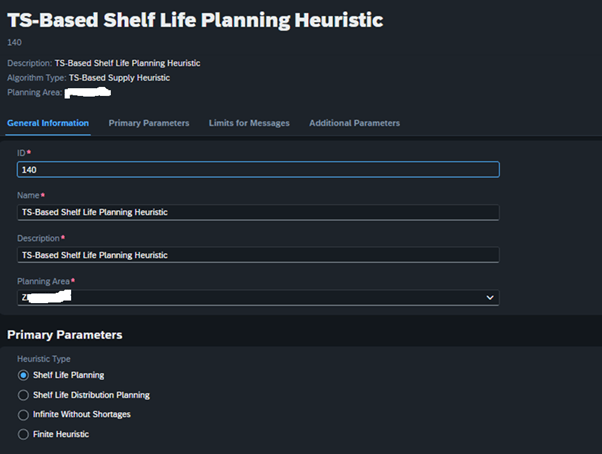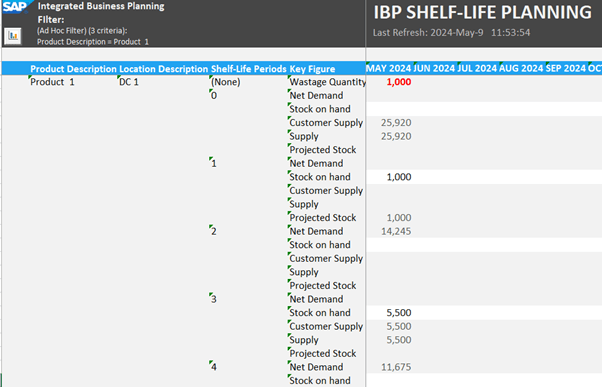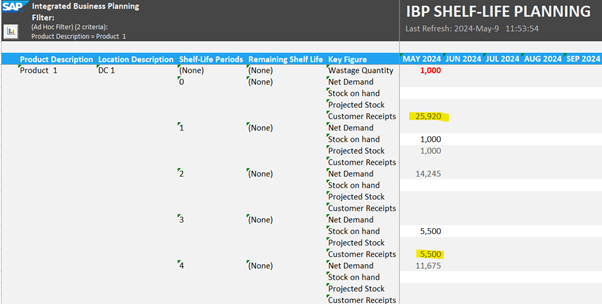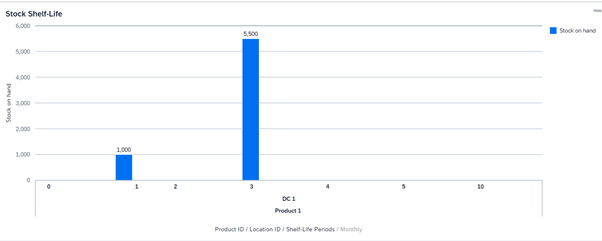Ultimate Guide to Shelf-Life Planning in SAP Integrated Business Planning (IBP)
Publish Date: May 31, 2024A Comprehensive Guide to SAP IBP Shelf Life Planning
Introduction to SAP IBP Time Series Shelf-Life Planning
Effectively managing the shelf life of products is critical to supply chain management, particularly for industries dealing with perishable goods. SAP Integrated Business Planning (IBP) offers robust solutions to enhance this process, ensuring businesses minimize waste and improve product turnover.
SAP IBP’s time series shelf-life planning is designed to forecast and manage the expiration dates of products efficiently across the supply chain network. It supports businesses in making informed decisions, ultimately enabling optimal inventory levels and fresher products to market.
Overview of SAP Integrated Business Planning (IBP)
SAP Integrated Business Planning (IBP) is a cutting-edge planning application that allows organizations to integrate their supply chain, operations, sales, and business planning into a single cloud-based platform. The platform employs advanced analytics to help forecast future demand and optimize supply plans, ensuring alignment across all departments. SAP IBP uses real-time data, allowing businesses to make quick decisions and adapt to market changes efficiently.
Key Features of Shelf-Life Planning in SAP IBP
Shelf-life planning in SAP IBP helps manage products with a limited shelf life. The key features include:
Expiry Date Tracking: This allows businesses to track the shelf life of products throughout the supply chain, ensuring that no expired goods are made available for customers.
- FEFO (First-Expired, First-Out) Logic: Integrating FEFO logic ensures that products with imminent expiry dates are prioritized in dispatch, reducing wastage.
- Dynamic Safety Stock Levels: SAP IBP adjusts safety stock levels based on products’ remaining shelf lives, ensuring optimal stock levels are maintained.
Benefits of Implementing Shelf-Life Planning in SAP IBP
Enhanced Inventory Management
Implementing shelf life planning in SAP IBP enhances inventory management significantly. With features like expiry date tracking and dynamic safety stock levels, businesses can dramatically reduce stock spoilage and excess inventory, leading to cost savings and less waste. Moreover, the system ensures that the oldest stock gets used first, aligning with compliance standards and reducing financial loss due to expired products. Having a robust inventory management system in place also improves overall operational efficiency.
Improved Product Freshness and Compliance
Shelf-life planning ensures that products are always fresh when they reach the consumer, essential for businesses dealing with perishable goods. Companies can enhance customer satisfaction through consistent product quality by managing the supply chain effectively using SAP IBP’s time series data and FEFO logic. Furthermore, it helps companies comply with industry regulations and standards by ensuring product handling follows the best-in-class shelf-life management practices. Compliance is not just about meeting legal requirements but also about enhancing brand reputation and customer trust.
Increased Efficiency in Supply Chain Operations
Integrating shelf-life planning into SAP IBP streamlines various components of the supply chain. From production planning to inventory management and distribution, every stage gets optimized to handle perishable products efficiently. This leads to reduced lead times, faster fulfillment rates, and resilience in operations. Additionally, predictive analytics help make informed decisions, optimize resource utilization, and reduce wastage, empowering businesses to operate more sustainably. Overall, increased efficiency in supply chain operations can lead to significant cost savings and improved profitability for the company.
Setting Up Shelf-Life Planning in SAP IBP
The setup involves several detailed steps, from integrating essential shelf-life data to configuring time series models.
Integrating Shelf-Life Data into SAP IBP
Integrating shelf-life data is critical to optimizing inventory and reducing waste. It is accomplished by feeding detailed product information into SAP IBP, which includes expiration dates, production dates, and storage requirements. Here’s how to integrate this data:
- Data Collection: Gather complete and accurate data about product manufacturing and expiration dates from internal and external sources.
- Data Mapping: Map this data to corresponding fields in the SAP IBP model, ensuring that it aligns with the data’s representation in other business systems
- Continuous Updates: Ensure that data about product shelf life is consistently updated and accurate, which is crucial for maintaining operational efficiency and minimizing losses due to expired products.
Configuring Time Series Models
Time series modeling is essential for shelf life planning in SAP IBP. It enables businesses to forecast product demand while considering expiration dates. When configuring time series models, companies should define the planning area and specify critical figures for tracking, including production, supply chain constraints, and sales forecasts. These models help make predictions based on historical data and adjust plans according to real-time market changes.
- Define the forecast horizons: Based on your product’s shelf life, determine how far into the future the model needs to predict.
- Adjust model parameters: Improve forecast accuracy by setting up factors such as seasonality, trends, and cyclic behavior.
- Incorporate constraints: Include constraints related to supply chain capacities, storage conditions, and transportation methods, which impact product shelf life.
Shelf-life Planning Heuristic
Shelf-life planning creates a supply plan considering the minimum remaining shelf life (MRSL) of independent demands, the remaining shelf life of existing stock on hand, and the upcoming supply.
The shelf-life planning heuristic helps consider product shelf life when creating supply plans. It effectively balances supply and demand to ensure there are no shortages.
This heuristic is similar to the time-series-based supply planning heuristic but focuses explicitly on shelf life. It does not support all the features available in other heuristic methods, but it provides a comprehensive solution for shelf-life planning.
You need to configure a planning area to use the shelf-life planning heuristic. You can create a new planning area copied from SAP4S or modify an existing one.
The SAP4S sample planning area provides a good starting point, containing the necessary master data types, attributes, key figures, and planning levels for shelf-life planning.

A shelf-life planning heuristic is a sophisticated tool that incorporates many functionalities, such as verifying source authenticity, accommodating multiple modes of transportation, managing lead times, enabling co-production, navigating subnetworks, implementing a frozen horizon, categorizing demand, and refining lot sizing procedures. Crucially, it is adept at accounting for the shelf life of components whenever necessary.
Furthermore, this heuristic thoughtfully assesses the minimum required shelf life (MRSL) and the desired shelf life, providing a comprehensive overview of the supply network. It includes an intricate consideration of the journey from customers and their demands through distribution centers and manufacturing plants to the suppliers. It factors in transportation lead times and time granularity in its planning process.
Despite its extensive capabilities, the shelf-life planning heuristic currently does not support a few features, including specific lot sizing procedures and parameters, batch-level supply, location product substitution, and enhanced time accuracy. However, tailored customer solutions are available to meet some of these specific needs.
The shelf-life planning heuristic is invaluable for integrating product shelf-life considerations into developing efficient and effective supply plans.
Mandatory Master Data required—Minimum Required Shelf-life (MRSL)
For each customer-product combination, maintain the Minimum Required Shelf-Life (MRSL), which means the customer does not want the product’s shelf-life stock below a certain threshold. For example, if the MRSL is set to 2, the customer only accepts stock with a shelf life of 2 or more periods.
Shelf-life Period
SHELFLIFEID is crucial for several vital figures when generating a supply plan. A table containing shelf life values from zero to 400 (assuming the maximum shelf life value is 400 or lower) needs to be created to ensure all possible combinations are accounted for. This table should contain 401 records with a SHELFLIFEID value and a corresponding description.
Supply Planning Operator

Customer 1 & Customer 2 Demand

Total Customer Demand:31420

Customer 1 has a requirement of MRSL 2 periods
Customer 2 has a requirement of MRSL 4 periods

We have Stock at DC:
Stock of 1000 with Shelf Life Period 1
Stock of 5500 with Shelf Life Period 3
A stock of 1000 is going to waste as Customer 1 and Customer 2 MRSL are 2 and 4 periods, respectively. Therefore, we cannot use this stock to fulfill any demand. The stock of 5500 can partially fulfill Customer 1’s demand.

Production is carried out for 25920 demand qty.
The screenshot below depicts customer receipts in the network and how they fulfill customer demand.

Business users can create Analytics quickly in IBP using Analytics stories, which will help them see stock shelf life in the system.

Conclusion:
By leveraging the advanced SAP IBP Shelf-life Planning, businesses get a comprehensive solution that ensures effective inventory management and product freshness across the entire supply chain. This technology employs a cutting-edge, time-series-based shelf-life planning heuristic, allowing businesses to reduce waste, enhance customer satisfaction, and achieve operational excellence in today’s competitive market. As a leading global SAP Partner, YASH Technologies can further augment this capability. YASH brings expertise in architecting solutions, providing customized organization-centric advisory, implementing and optimizing SAP solutions, and ensuring businesses can fully harness the potential of SAP IBP Shelf-life Planning to meet their specific needs and goals.
Stay tuned for upcoming SAP IBP blogs in this space.

















